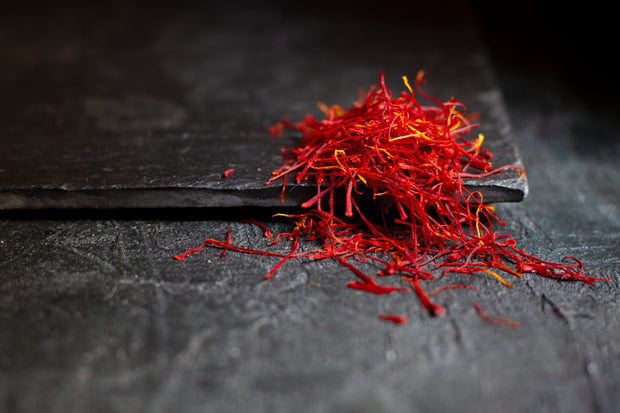Recognizing real saffron – How to recognize the best quality saffron

** Genuine saffron ** is one of the most expensive spices in the world and is extracted from the stigmas of the Crocus sativus plant. To distinguish **genuine saffron** from fake or inferior saffron, several characteristics must be considered. Here is some detailed information based on scientific sources:
1. Appearance
True saffron consists of narrow, long threads that have a deep red color. These threads are typically between 2 and 4 cm long and have a characteristic shape. They consist of three parts:
- **Red part:** The main part, which contains most of the aromatic compounds.
- **Yellow part:** This part is less aromatic and is often considered inferior.
- **White part:** The bottom part of the thread, which is often not used.
Scientific source: Studies show that the chemical composition of real saffron , especially the levels of **crocin** (the color), **picrocrocin** (the flavor) and **safranal** (the aroma), is crucial for its quality (Khan et al., 2018).
2. Coloring
True saffron has the ability to color water a golden yellow hue when steeped. This is due to the carotenoids contained in the threads, particularly crocin. Fake saffron, often made from other plants or synthetic dyes, can color water in unnatural colors such as red or orange.
Scientific source: A study of saffron samples has shown that the dyes in genuine saffron have specific absorption spectra that differ from those of counterfeit products (Moussa et al., 2020).
3. Scent and taste
True saffron has an intense, unique fragrance, often described as floral and slightly sweet. The taste is slightly bitter and very aromatic. These properties are due to the chemical compounds in saffron, particularly picrocrocin and safranal.
Scientific source: The sensory properties of saffron have been investigated in several studies, highlighting the importance of chemical composition on taste and aroma (Zarshenas et al., 2015).
4. Origin and price
True saffron comes primarily from specific regions, such as Iran, Spain, and India (especially the Kashmir region). The price of true saffron is generally very high, due to the laborious harvesting process. One kilogram of saffron requires the harvest of approximately 150,000 to 200,000 flowers.
Scientific source: Economic analyses show that the production costs and market price of saffron depend strongly on its origin and quality (Kumar et al., 2019).
5. Laboratory tests
For definitive confirmation of authenticity, a chemical analysis can be performed. Laboratory tests can measure the concentrations of **crocin, picrocrocin, and safranal** and thus determine the quality of the saffron.
Scientific source: Analytical methods such as **high-performance liquid chromatography (HPLC)** are commonly used to verify the chemical composition of saffron (Ghaffari et al., 2021).

Conclusion
To identify genuine saffron, you should pay attention to its **appearance, color, aroma, and taste**. It's also advisable to inquire about the **origin and price** of the product. If in doubt, **laboratory testing** can be a reliable method of confirming authenticity. With this information, you'll be better equipped to distinguish real saffron from fake.
Frequently asked questions about identifying real saffron (FAQ)
Authentic saffron can be recognized by its deep red color, intense aroma, bitter taste, and typical thread structure. When soaked, it turns water golden yellow—not orange or red.
False saffron is often made from dyed plants or artificial substances. It usually has no characteristic odor, colors water unnaturally, and contains none of the typical compounds such as crocin or safranal.
Because up to 200,000 crocus blossoms must be harvested by hand to produce one kilogram of saffron. The process is labor-intensive and yields are low, which significantly increases the price.
Real saffron colors water a clear golden yellow. If the color turns red or orange, this is an indication of possible counterfeiting or additives.
The three main substances are:
- Crocin (for the color),
- Picrocrocin (for the bitter taste),
- Safranal (for the aroma).
These determine the quality and authenticity.
A simple test: Put a few strands in warm water. Real saffron slowly releases a golden yellow color while retaining its thread shape. Fake saffron dyes immediately and dissolves.
The most well-known growing areas for high-quality saffron are:
- Iran (largest exporter worldwide).
For more information about saffron
Chemical composition of saffron




